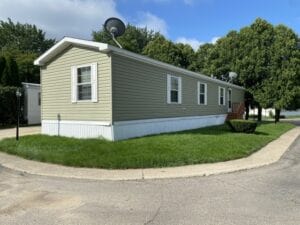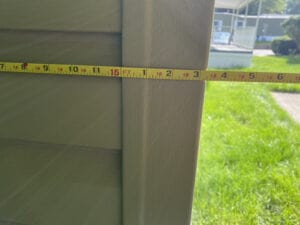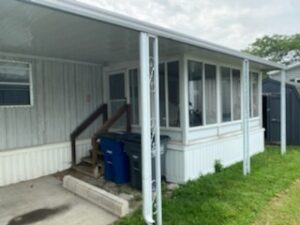Did you know that the average width of a singlewide mobile home is surprisingly narrow, typically ranging from 14 to 18 feet? Despite their slender build, these homes offer cozy and functional living spaces that might just defy your expectations. From clever design solutions to maximizing every inch, singlewides showcase how less can indeed be more when it comes to comfortable living arrangements. If you’re curious about the dimensions of these compact yet charming homes, buckle up for an insightful exploration in this article, “How Wide Is a Single Wide Mobile Home”
Single-Wide vs. Double-Wide Overview
Construction and Size
Single-wide mobile homes are typically 18 feet wide or less, whereas double-wide mobile homes are at least 20 feet wide, offering more space. These homes are built in one piece, while double-wide homes are constructed in two separate sections that are later joined together.
Single-wide homes have a more compact layout, suitable for individuals or small families. On the other hand, double-wide homes provide larger rooms and more amenities, making them ideal for bigger families or those looking for extra space. The construction of single-wides tends to be simpler, while double-wides require more intricate assembly due to their larger size.


Key Characteristics of Single-Wides
Cozy Layout
Single-wide mobile homes are known for their cozy and narrow floor plans, offering a compact living space that fosters a sense of intimacy. The limited width of these homes creates a snug environment that is easy to maintain and keep organized.
Affordability and Mobility
One of the key advantages of single-wide mobile homes is their affordability and ease of relocation. These homes are typically more budget-friendly compared to larger housing options, making them an attractive choice for individuals looking to own a home without breaking the bank. Their compact size allows for quick and hassle-free transportation to different locations.
Room Layout Limitations
Due to their long and narrow shape, single-wide mobile homes come with limited room layout options. The elongated structure restricts design possibilities, often resulting in linear floor plans that may lack the flexibility seen in larger dwellings. Homeowners must carefully plan the arrangement of furniture and fixtures to optimize the available space efficiently.
Dimensions and Floor Plans
Single-Wide Home Sizes
Single-wide mobile homes typically range from 12 to 18 feet wide and 40 to 80 feet long, providing a compact living space. These homes are designed to maximize functionality within a limited footprint, offering a cozy yet practical layout for residents.
Square Footage Comparison
In terms of square footage, single-wide homes generally offer less living space compared to double-wide homes. The average square footage of a single-wide home ranges from 600 to 1,330 square feet, making them ideal for individuals or small families seeking a more affordable housing option without compromising on essential amenities.
Layout Challenges
The long, narrow shape of single-wide mobile homes can present layout challenges when designing the interior space. Homeowners often need to carefully plan the arrangement of furniture, appliances, and storage solutions to optimize the available space efficiently. Despite these challenges, innovative design solutions such as open floor plans and multi-functional furniture can help create a comfortable and stylish living environment within the constraints of a single-wide home.
Mobility of Single-Wide Homes
Relocation Advantages
Single-wide mobile homes offer convenience in relocation compared to double-wide models. Their narrower structure makes transportation easier and more cost-effective.
Moving a single-wide home requires less time and resources, making it an ideal choice for home buyers seeking flexibility in changing their living location.
Mobility Benefits
For individuals who prioritize mobility, single-wide homes are a practical solution. They provide the freedom to easily relocate without being tied down to a specific home site.
Single-wide homes are often more affordable than larger options, appealing to those looking for a budget-friendly housing solution that can adapt to different locations.
Considerations and Limitations
While single-wide homes offer mobility advantages, they may have limitations based on state regulations. Some states have restrictions on where these homes can be placed or require specific permits for relocation.
Homeowners considering moving a single-wide home should factor in potential costs for disassembly, transportation, and reassembly at the new location.

Cost Analysis for Single-Wides
Average Cost Breakdown
A single-wide mobile home typically costs around $73,000 in 2021. This price includes the basic structure and may vary based on location and additional features.
Comparison with Double-Wides
Compared to double-wide homes, single-wides are generally more affordable due to their smaller size and simpler construction. On average, double-wides can cost $100,000 or more.
Factors Influencing Pricing
Several factors contribute to the pricing of single-wide mobile homes. Location plays a significant role, with prices varying between states and regions. Size and features such as upgrades, appliances, and materials used also impact the overall cost.
Pros:
Lower initial investment compared to traditional homes.
Easier maintenance and upkeep due to smaller size.
Cons:
Limited space compared to larger housing options.
Resale value may not appreciate as much as traditional homes.
Resale Value Insights
Trends
Single-wide mobile homes typically have a lower resale value compared to larger, multi-sectional homes. The resale price of a single-wide home is influenced by various factors, including its age, condition, location, and market demand.
Factors Affecting Resale Value
Buyers often consider the value they are getting for their money when purchasing a single-wide home. Upgrades such as new appliances, flooring, or roofing can positively impact the resale value. However, structural issues or outdated features may decrease the home’s value.
Tips for Maximizing Resale Value
Keep the home well-maintained to attract potential buyers.
Enhance curb appeal with landscaping and exterior improvements.
Consider investing in energy-efficient upgrades to appeal to environmentally-conscious buyers.
Highlight any recent renovations or upgrades when listing the home for sale.
How Easy is it to Add On to a Singlewide to Make it Wider?
Although it is not without difficulty to add on to a singlewide, it absolutely is possible and many chose to do so because they want a garage, storage room, deck, or a sunroom.
Adding an addition can give you more living space and great views of your yard.

Pros and Cons of Single-Wides
Affordability
Single-wide mobile homes are highly affordable, making them an attractive option for individuals on a budget. The initial cost of purchasing a single-wide is significantly lower than that of a traditional home.
Mobility
One significant advantage of single-wide homes is their mobility. These homes can be easily transported to different locations, providing flexibility for homeowners who may need to move frequently or desire a change of scenery.
Limited Room Layout Options
On the downside, single-wide mobile homes typically have limited room layout options due to their narrow structure. This can restrict customization and interior design choices for homeowners looking for more spacious layouts.
Comparison with Double-Wides
When comparing single-wide homes to double-wides, one key difference is the size. Double-wides offer more space and a wider range of layout possibilities compared to single-wides. However, this comes at a higher cost and potentially reduced mobility.
Pros:
Affordability
Mobility
Cons:
Limited room layout options
Making the Right Choice
Key Factors
When deciding between a single-wide and double-wide mobile home, consider your current needs and future plans. Evaluate the size that best suits your family, taking into account the number of children or potential additions.
Budget Considerations
Before making a decision, carefully assess your finances. Single-wide homes generally cost less upfront, but double-wides offer more space and potential for upgrades. Financing options may vary between the two types.
Lifestyle Needs
Think about how you plan to use the space. Single-wides are ideal for individuals or small families looking for a cozy living arrangement. Double-wides provide more room for entertaining, accommodating guests, or creating separate areas within the home.
Future Planning
Anticipate your future needs when choosing between single-wide and double-wide homes. Consider any possible lifestyle changes, such as growing families or aging parents moving in. Flexibility is key to ensuring your home continues to meet your needs over time.
Conclusion
Hopefully, this blog can help lead you to the exciting decision of buying a singlewide mobile home for you and your family! Now you won’t be asking the question, ” How wide is a single wide mobile home ?”
FAQ’s: How Wide Is a Single Wide Mobile Home
How wide are most single wide mobile homes?
Most single wide mobile homes typically have a width of 14 to 18 feet, with 16 feet being a common width.
What is the smallest single wide mobile home?
The smallest single wide mobile homes can be around 14 feet in width and vary in length, with lengths typically ranging from 42 to 76 feet.
Is a single wide the same as a mobile home?
A single wide mobile home is a type of mobile home. “Mobile home” is a broad term that includes both single wide and double wide homes, while “single wide” specifically refers to a mobile home with a narrower width.
How tall are the walls in a single wide mobile home?
The walls in a single wide mobile home are typically about 8 feet in height, similar to the standard wall height in many traditional houses.
Be sure to check out these articles:
